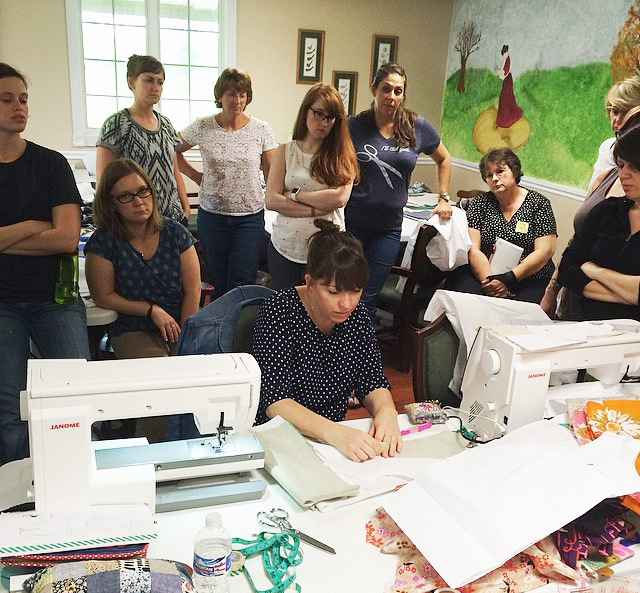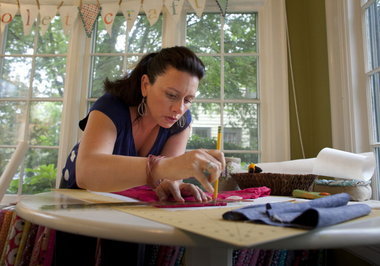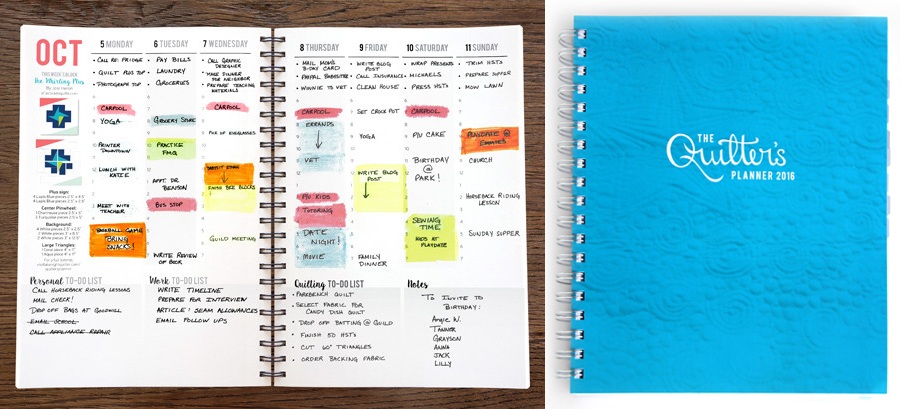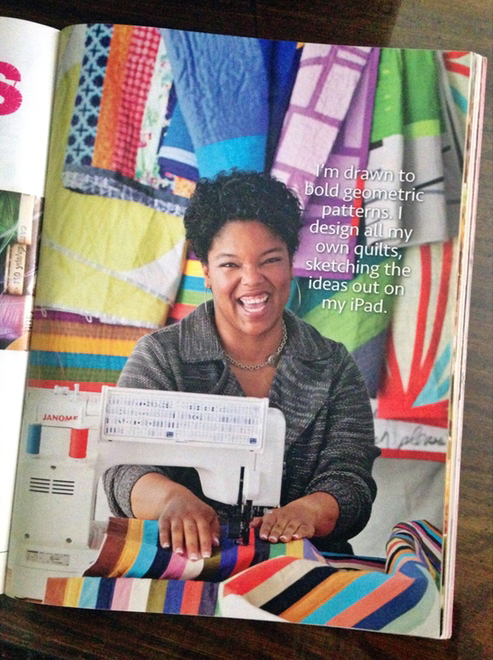
Christine Haynes teaching a class.
Photo courtesy of Christine Haynes
In July of 2011, Christine Haynes—at the time a sewing instructor, custom garment maker, and writer—was ready to launch a new line of printed clothing patterns for women. Her designs were graded, the art for the covers was finished, the foundation for the business was in place, and she had built a supportive network within the sewing community. What she didn’t have was cash on hand, or even credit to pay for the minimum order from the printer for her first three patterns. She decided to take her venture to Kickstarter, a fairly new-at-the-time crowdfunding platform for creative projects. She launched her campaign with a goal of $6,500 and within 30 days she had raised over $6,800. Success! Or maybe not…
Today Haynes uses terms like, awful, embarrassing, and traumatic to describe her Kickstarter experience. It’s not that she made huge mistakes, it was just a matter of little things adding up—asking friends and family to give or share throughout the campaign, as well as making and shipping the rewards afterward was much harder than she expected.
“It was the most exhausting time of my life,” she says. “When I ask myself if it was worth it, the answer is yes, since I wouldn’t have been able to launch without doing the campaign. But I wish there was another option for me at the time. There just simply wasn’t.”
Haynes isn’t alone in feeling wrung-out, shame-faced, or overwhelmed by her crowdfunding experience. Talk to nearly anyone who has used the alternative financing model to raise money for their project or business and they’ll almost always have a regret or two. Although crowdfunding may at first seem like the perfect no-risk option for raising money to realize a dream, when done right, most campaigns require a great deal of pre-launch preparation, constant mid-campaign marketing, and tireless post-funding follow up.
Despite all the hard work involved and several high-profile disasters, crowdfunding can still be an excellent option for entrepreneurs—especially for those in creative industries. It can be a great way to raise capital. It can also be a terrific marketing tool that provides you with a platform to prove your concept and it’s accessible to almost anyone. With preparation, organization, and realistic expectations, crowdfunding can help you launch a business, produce a new product, or actualize a dream project.
On nearly every crowdfunding platform, business magazine, or blog for entrepreneurs you’ll find plenty of pointers about planning a great funding event. Nothing, however, compares to hindsight so I asked five members of the crafting community to talk about their crowdfunding experiences—what they learned, what they’d advise, and what they wish they’d done differently—and boiled their results down a few commonalities. If you’re considering crowdfunding to finance your next big initiative, you’d be wise to first answer these essential questions.
Do You Really Want to Ask Your Friends for Money for That?
One of the first things to consider is whether or not the things you want to finance are even appropriate for crowdfunding. “Appropriate” is, of course, a very subjective concept, but The Internet definitely has its opinions. (I’m leaving aside all the campaigns for personal expenses such as adoption fees, medical bills, and court-ordered restitution—all hornets’ nests in their own right—and focusing on creative business funding.) For years I’ve been listening to the quiet online grumble about the inappropriateness of crowdfunding campaigns that include new office furniture, central air conditioning, or travel expenses for “research.”

Shelly Figueroa
Photo courtesy of Shelly Figueroa
Shelly Figueroa, the designer behind Figgy’s Patterns and the co-founder of the Lake Oswego, Oregon classroom studio and makery, Nic & Fig’s, launched an Indiegogo campaign several years ago when she was first trying to move from teaching sewing classes in her home to opening her own studio. Ultimately, she did not reach her $20k financial goal (although she’d go on to open a bigger and better studio later) and in hindsight understands that although the members of the online community she had built around her pattern line were verbally supportive, they weren’t from the local neighborhood she was trying to reach, so they were unlikely to give money. Shelly advises entrepreneurs who are thinking about crowdfunding to ask themselves, “Does this fill a large need? Does it solve an issue? Or is it a product that makes you think, ‘wow, why didn’t I think of that!’”
If you can’t answer yes to any of those questions, it might be best to look for another source of funding for certain aspects of your project and narrow the scope of your campaign. When in doubt, ask your friends and community for honest input before you launch. The truth is, investors, funders, pre-buyers, and observers are becoming more cautious and critical about the quantity and the quality of campaigns they see. It’s always a good idea to put your best, most professional foot forward, so make sure you’ve carefully considered the implications of all the items you’ve bundled into your funding goals. It might be possible to get bank credit or loans from family to pay for some of the things the online community might not support.
Which platform will you use?
There are literally dozens of different crowdfunding platforms currently available—many of them specific to certain business sectors or types of projects. For craft industry professionals, the choice will usually come down to Indiegogo or Kickstarter.
Although there are some differences in eligibility requirements, platform costs, audience reach, and marketing strategies, a lot of people end up deciding which platform to use based on the funding model. Kickstarter uses an all-or-nothing model, meaning that if you don’t reach your funding goal you don’t get any of the pledged money. Indiegogo, on the other hand, has both all-or-nothing and flexible, or keep-it-all options.
Stephanie Palmer, the designer behind Late Night Quilter, completed a successful pre-order campaign for The Quilter’s Planner, a 2016 day planner that has recently landed in the hands of very happy and impressed funders. Stephanie chose Indiegogo because of the flexible funding options. She says that even though she read that Kickstarter’s vast reach and funding model is more likely to help you hit your goal, “these reasons were not enough for me to risk being unfunded and having to contact all the people who may have supported me…only to tell them that I would not be printing the planner. That simply was not an option in my mind. I love our quilting community and would have been mortified if I had to back out on a project.”
Stephanie Palmer shipping Quilters Planners.
Photos courtesy of Stephanie Palmer

The Quilter’s Planner cover and Weekly calendar spread.
She points out, however, that “Kickstarter is significantly larger (6 times larger) than Indiegogo, so if you have a product that appeals to a wide variety of shoppers who might be browsing Kickstarter and will happen upon your product, then Kickstarter might be the right choice.”
Figueroa also chose Indiegogo and is glad she did. Even though she didn’t reach the funding goal that would have allowed her to open a new studio, the money that she did raise helped her purchase tables, chairs, and supplies, making it possible for her to increase the number of students she could have in her in-house classes.
Are you prepared to develop a high-quality campaign?
Here’s the thing about crowdfunding campaigns—they’re permanent. As in forever and ever. Kickstarter’s Help page states,
How long does a project remain on Kickstarter?
Forever! Projects are not closed or taken down, they remain on site for reference and transparency.
For the same reasons, projects cannot be deleted, even if they were canceled or unsuccessful. Please note that deleting your Kickstarter account will not delete your project.
What this means is that years from now, long after you’ve built your empire, people are going to be able to look back and see the project that started it all. And chances are good that they will see it. Because Kickstarter and other big crowdfunding websites like Indiegogo and GoFundMe get lots of traffic and are optimized by pros, their pages rank high in search results, so when someone searches for your name or your business, your crowdfunding project will probably display on the first page of results.

Sam Hunter
Photo courtesy of Sam Hunter
Do a Google search for a product like Passion Planner and you’ll see that the company’s Kickstarter project ranks directly below their website and Facebook page. Once the horse is out of the gate, you can’t put it back in and you can’t hide it, so make sure it’s something you’re proud of.
A polished campaign also helps you reach your project goals so it’s wise to produce the best quality text, video, and images you can. Sam Hunter of Hunter’s Design Studio used Kickstarter to fund her first vendor booth at a quilt show. She used publicly-available viewing data to figure out how long to make her video. She says, “You need a solid video that is less than a couple minutes long, preferably 60 seconds…Not too slick though or people will think you’re asking for money you don’t need.”
Figueroa agrees that a video is almost always a good idea. “People want to know you and feel close to you before they give you their hard-earned money…I loved my video and look back on it as a wonderful start on my journey.”
Are you sure you want to offer handmade rewards?
If there is one thing that every person I spoke with emphasized, it’s the importance of carefully-considered rewards. As an artist or maker, it may be very tempting to include handmade goods as funding incentives, but you have to think about the cost as well as the time and effort involved in meeting those post-campaign obligations.
Latifah Saafir recently ran a spectacularly successful campaign to fund her quilt patterns, a new line of sewing patterns for kids, and a few acrylic quilting rulers. She reached her first goal within 36 hours, and also funded two stretch goals by the end of the month. Despite great planning and organization, she’s run into a few hitches with the rewards. Saafir says, “If it’s a business project, I definitely think your rewards should be pre-order rewards. I think that’s the only way to go and I wish I had limited that because when it gets down to it, you want to spend your time working on your business and developing the products for your business and not (as in my case) making quilts or making handmade items.” Although she’s very grateful that someone bought the $2000 reward for a custom quilt, at a time when she needs to be focusing on all the different aspects of a new business, the quilt is somewhat of an albatross.
Haynes would agree. “Hand making everything was so hard I ended up getting help…I am pretty embarrassed about some of the rewards people got…I would advise people to minimize how much you promise that’s handmade.”
Even if you’re just mailing out thank you cards, temporary tattoos, or pre-printed tote bags, it all takes time and money. Don’t forget that at the end of your campaign you want to be focusing on your project and business goals, not filling rewards orders that might not have been necessary in the first place.

Is your timeline realistic?
No matter what sector you look in, the most common crowdfunding mistake people make is setting an unrealistic timeline for shipping rewards, launching a project, or having products available for purchase. Just do a search for Coolest Cooler to see how a project can go from a spectacular success to a spectacular disaster within a matter of months.
Often the manufacturer or printer is to blame—they underestimated the amount of time it would take them to turn the product around, or the order was larger than originally planned. It’s a good excuse, but the public’s frustration is still directed at the project’s owner. The backlash can take its toll on your company’s reputation, and your own confidence.
Saafir says everything took a little longer than she expected. Getting things ready for the printer was a learning curve, as was working with the acrylic ruler manufacturer for the first time. Even though she was well prepared, there were many things she couldn’t do in advance because they were dependent on the funding. She recommends, “For your expected delivery times, give yourself at least 2 months buffer, just because life happens.”
For pre-order campaigns, Saafir suggests, “One thing you may want to consider adding into your budget is an order fulfillment service. When you have 300 orders that have to be packaged and shipped, it takes time and energy…If you figure out and budget for an order fulfilment service early on, it will save you a lot of time and headache down the road.”
Did you consider all your costs?
Nearly everyone I talked to emphasized how important it is to consider all the expenses you’ll have before you set your funding goals. In addition to the actual costs of achieving your business goals (the reason you’re raising capital in the first place), you’ll have a host of other expenses. These include all the costs associated with preparing your campaign, such as videographers and graphic designers; the costs associated with rewards, such as manufacturing and shipping; the costs associated with the campaign itself—that is the cut that the crowdfunding platform takes off the top; and finally, the cost of your own time. If you have to take a few days off work in order to follow up on your campaign, you need to consider those budgetary implications. If possible, have someone budget-savvy go over all your expenses to make sure you’ve set a realistic funding goal.

Photo courtesy of Latifah Saafir
Are you ready to do the necessary marketing?
Last but not least, before you launch your crowdfunding campaign, you need to make sure you’re ready to actually draw the crowd. Palmer says, “It’s important to think about how the message will be shared among the people in your community. I asked many of my online friends to share the project when it went live with Indiegogo. The more people who shared, the more people saw the project. This was essential. The research shows that people who are active in their online communities are much more likely to have successful campaigns.”
Sam Hunter agrees. “You need a crowd of backers to talk to, ask from and email. So if you’ve never blogged before, and you don’t have any followers, you’re probably going to die on the vine.”
Asking your friends and community to support your project isn’t easy though. Hunter says, “You have to be super comfortable with asking, and asking, and asking people to help you. It’s really hard to do as it feels like nagging and begging. And you need to work at it daily. It’s exhilarating and harrowing.
Haynes perhaps sums it up best. “It’s the most humbling thing I’ve ever done.”
Have a crowdfunding story or advice to share? Post it in the comments, we’d love to hear from you.
Kickstarter and several other crowdfunding platforms are Benefit Corporations and/or B Corp Certified. Learn what that means in this article.
+++++
Running a small business can get complicated around tax time. We’ve created a free guide to small business tax deductions to help simplify the process. Click the button below and we’ll email it to you!

I’m new to quilting but love it. I bought the quilter’s planner off of IndieGogo and I love it. So awesome to be connected to other quilters. As a guy, its a lonely hobby that my buddies don’t understand…
I have only ever contributed to one crowdfunding campaign for a product and it was because the product itself was so overwhelmingly fascinating to me. For my (level of) contribution I received a first edition of the item. Even if I had as cool an idea as those folks, I think embarrassment would prevent me from trying. It was uplifting to read the successes and what kind of work is involved, but also validating how difficult and how truly personal this process is and how vulnerable it can make you feel.
I have bought in on two different crowd funding campaigns. The first was to help a fellow quilter in Australia, Nightingale Quilts, build a bat enclosure. She works as a volunteer bat rescuer. The second was the Quilter’s Planner. I was happy to be a part of both campaigns. (And I really love my planner!) Both of them I learned about from people in the quilting community sharing on Instagram.
Excellent article Kristin! I know from some of our musician friends what a chore it can be to fulfill Kickstarter rewards, so it’s important to remember that going in. My husband works for a crowd-funding platform in the music industry, and he notices a huge difference when the artist has a well-planned campaign vs. one that is thrown together. Some of the musicians offer really interesting rewards (“I’ll tattoo your name on my body” or “I’ll marry you in Vegas for 24 hours”) to appeal to those “superfans” who have disposable income. Setting rewards at a range of price levels (super low to very high) is recommended, because you never know who you’ll catch reading your campaign. I always like when there is a low option, like $1 or $5, which can attract a casual supporter.
Thanks, Lindsay. I was going to include Amanda Palmer’s Art of Asking in this, but I decided to make it more practical and less “inspiration”. I wonder though if your husband feels like his platform has been heavily influenced by her work?
I supported the curve runner on kickstarter. It’s a tool for measuring around curves. I use it all the time and I love it. My favorite campaigns are for tools or gadgets.
I think you have to be prepared to develop a high quality campaign. Sometimes a little creative as well, think in the rewards closely. The most important of all is the outreach. Building connections and a network of support, finding backers that will contribute to the campaign. Well put together article Kristin. Here is some tips on rewards as well. https://www.thrinacia.com/blog/post/the-right-rewards-in-crowdfunding